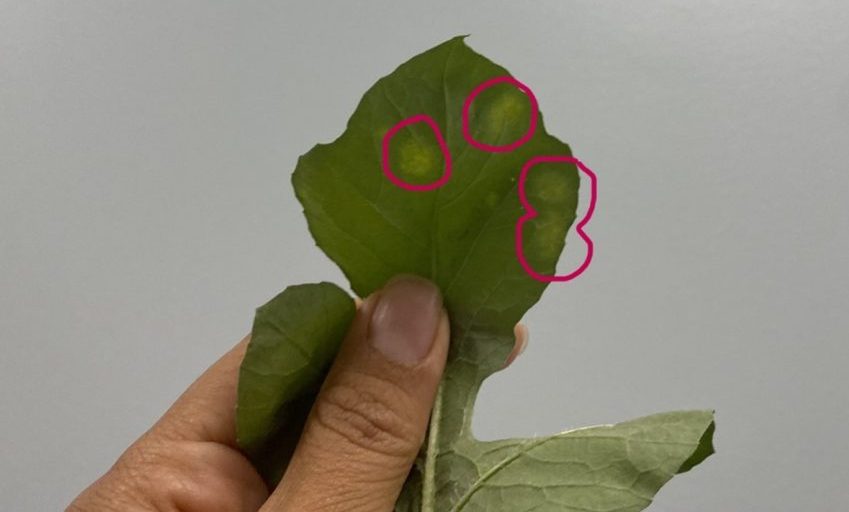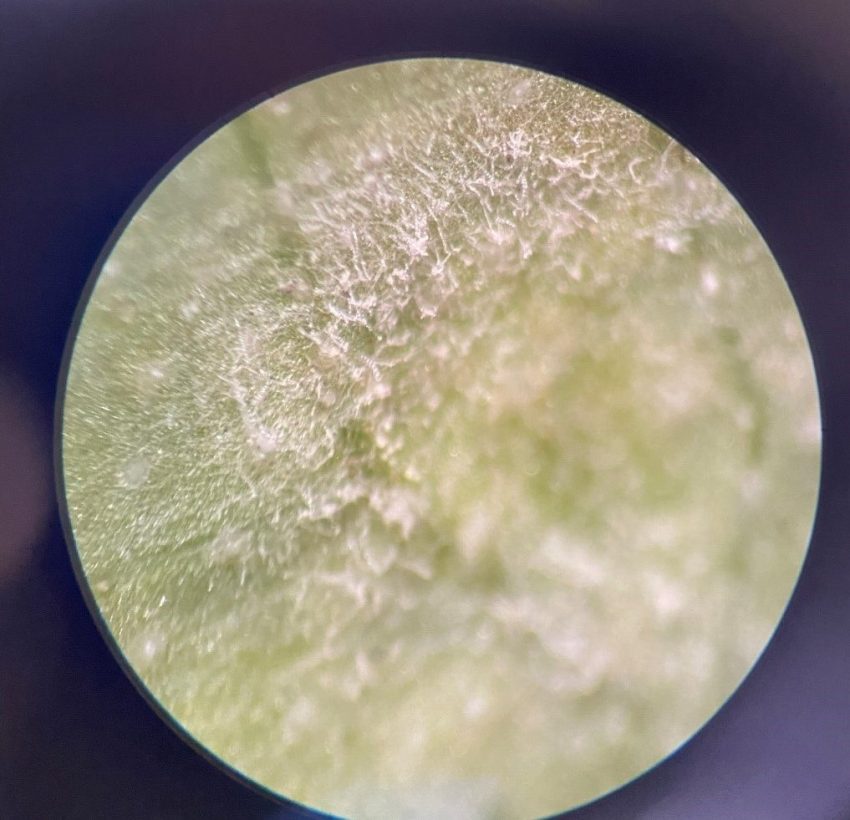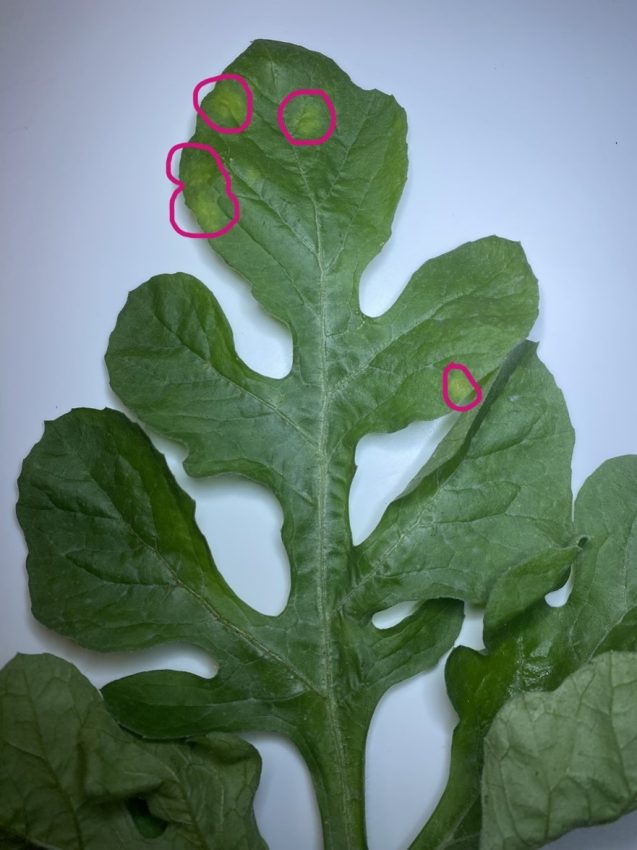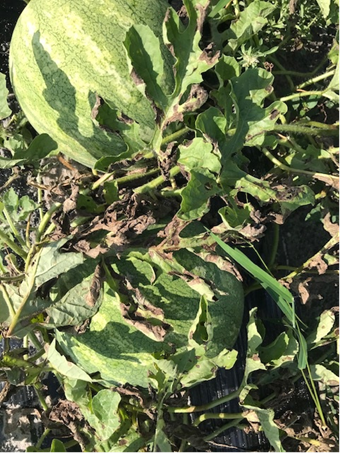Welcome to this week’s UF/IFAS Extension Suwannee Valley Watermelon Crop Update. This update covers the last two weeks, as the last one ran in our Panhandle Ag newsletter was April 29. These updates are summarized by Bob Hochmuth, Regional Specialized Extension Agent- Vegetable Crops, with input from Suwannee Valley Extension Agents: Mark Warren (Levy), Tyler Pittman (Gilchrist), Tatiana Sanchez (Alachua), Luke Harlow (Bradford), Dan Fenneman (Madison), Keith Wynn (Hamilton), Emily Beach (Lafayette), Jim Devalerio (Union), De’Anthony Price (Jefferson), Raymond Balaguer(Suwannee), Kevin Athearn (RSA-Agri- business), Shivendra Kumar (RSA-Agronomic Crops), Jay Capasso (RSA- Water Resources), and Bob H. covering vacant Columbia County position.
–
Insect & Disease Updates
Powdery mildew was confirmed in the Suwannee Valley area on Tuesday, May 7th. The disease was in its initial stages where it depends on the protected microclimate of the fully-grown vines to get the humidity it requires to establish and start sporulating. If you are scouting for powdery mildew, take a close look at the leaves and stems closer to the base of the plants. Look for small yellow areas in the leaves (mostly round) and whitish growth on stems and petioles (Fig 1.).
If you suspect you have lesions, hold the underside of the leaf against the light, infected tissue will appear lighter in color (Fig 2.).

Figure 2. Powdery mildew lesions showing the lighter colors on the leaf when shown toward the light.
You may not see the fuzzy growth just yet but if you collect suspicious tissue and put it in a moist chamber at room temperature, you will be able to see the white fuzzy growth characteristic of powdery mildew in just a couple of days (Fig 3.).

Figure 3. White fuzzy growth characteristic of powdery mildew in a growth chamber in just a couple of days.
–
First Case of Downy Mildew Confirmed
Well, we hoped we may could escape this season without seeing downy mildew. But, we now have our first confirmed case of the 2024 season for downy mildew in the southern part of the Suwannee Valley region (Mark Warren and Bob Hochmuth). See pages 40-41 in your UF/IFAS Watermelon Field Guide. In addition, I received a notice today from Ty Torrance, University of Georgia Extension Service, Tri-County Vegetable Agent for Colquitt, Tift, and Worth Counties that downy mildew was also confirmed in Tift County GA in watermelon. In both the Georgia and the Florida cases, the infection of downy mildew is very aggressive. It is unusual to have the situation where downy is found as far apart as southern Suwannee Valley all the way to Tift County, GA. Therefore, it is likely the entire Suwannee Valley is at risk. We do want everyone to have a heightened alert and to intensify scouting when we indicate alerts for any of these diseases or other pests. Our intent is to make sure everyone knows what is happening in the region, so you can make the best decision possible on your own farm.
Downy mildew is the disease traditionally known as “wildfire”. Last year, we confirmed the first case in our region on May 3, 2023. Because of the high risk of damage and movement throughout the region, we are expressing a high level of concern to consider a plan to spray if you have not already initiated a program targeted at downy mildew, anywhere in the Suwannee Valley region. Contact your Extension Agent if you see areas of the field where the plants look blighted (dried up leaves sticking straight up in the mid part of the canopy). The leaves in more advanced stages will quickly become “crispy” with the leaf veins being the only part of the leaf not to become crispy and dry (see Figure 1.). You should consider adding one of these fungicides to your program soon. The best choices, based on recent trials, are Ranman, Orondis Ultra, or Zampro (all three have a zero-day pre-harvest interval (PHI)) and should be added to a broader spectrum mancozeb (Manzate or Penncozeb (5-day PHI)) spray plus either Quintec, Rhyme, or Procure, for the continued management of powdery mildew. Good luck with this additional challenge. For those fields where downy mildew has been confirmed, we have suggested starting with Orondis Ultra or Zampro this week and Ranman next week. Where downy mildew has not yet been detected, you could start with Ranman this week and follow with Orondis Ultra, or Zampro. (Hochmuth)
A couple other disease notes. We also have confirmed cases of Anthracnose, Alternaria and Gummy Stem Blight. Of these, Gummy Stem Blight has been the most common in the region. The other two Alternaria and Anthracnose have been much less frequently found although have been very concerning in the few fields where they have been found. Again, if you see a disease symptom of great concern let your Extension Agent know so we can help confirm the cause. It looks like we will see a lot of changes in disease pressure now and moving forward.
–
Petiole-sap Nitrogen Dropping 1st Week of May
Perhaps the most common question and discussion was related to the significant decrease in petiole-sap nitrogen during the first week of May. As most of you know, the UF/IFAS Extension Agents in the Suwannee Valley offer a nutrient management service free of charge to growers in their county. This is a weekly service testing watermelon petiole sap for both nitrogen and potassium on over 5,000 acres of Suwannee Valley watermelons. The good news is that, in most cases, the potassium levels were on target, within the sufficient range (3500-4000 ppm K) for seedless watermelon crops with fruit half grown or larger. At this same stage, fruit half-grown, the nitrate-nitrogen levels should be 600-800 ppm. In fact, there were many fields with nitrogen level in this optimum range of about 600 ppm. However, there were many more fields that tested at levels of 200-400 ppm nitrate nitrogen (thanks Extension Agents and Beth Cannon). In many of those cases, the fields tested just fine the previous week. This is the same case for both conventional and controlled release fertilizer fields.
So, why such a significant drop? First, we see great fruit load in most all fields and seemingly a concentrated set of larger fruit (half-grown or larger). This high fruit load in conjunction with good to very good growing conditions over the past 10 days, has likely caused the crop to “pull hard” on the nitrogen reserves in the root zone. I have seen nitrate nitrogen levels drop from 800 ppm to 200 to 300 ppm in one week. I also have seen crops with great vine growth prior to last week, suddenly slow vine growth last week. This combination of what I “see” and what the sap numbers reveal match each other. For this stage of growth, our standard recommendation is 2.0- 2.5 lbs per acre per day of nitrogen and potash. In many of these low N cases, the crop was receiving less N than that recommendation. Note, as we begin harvests, the sap nitrate nitrogen level recommended range for seedless watermelon will go to 400-600 ppm. The other puzzling part is that the dry leaf tissue sampling does not seem to capture this same story, or at least, the lag time in getting results was not keeping up with the change in crop needs last week. As many of you have heard me say, I rely more on petiole-sap testing because it is very sensitive to changes in nutrient status, and we can give you results “right now” while in the field. The experiences this past week have only strengthened my resolve to the value of petiole-sap testing.
–
If you know someone who wants to be added to this weekly notice, contact your Extension Agent or Mark Warren (352-949-8288) if you want to be added to the regional watermelon group text app.
They have initiated a more formal way to support our watermelon growers with a rapid diagnostics system through Suwannee Valley Regional and County Extension Agents. This industry-funded program allows Extension Agents to submit and pay for watermelon grower’s plant disease and other diagnostic samples. This SV Rapid Diagnostic Watermelon Program will help us to get quicker diagnostic results, helping to give early alerts to everyone, and not have to charge the growers directly. Plant disease samples are typically $40 and leaf tissue analyses are typically $20. We are currently extending our solicitation of those industry reps interested in sponsoring this effort. The past year’s sponsorships have ranged from $200 to $2,000 per company. Sponsors will be recognized every week beginning this week. Those interested in being added as a sponsor can contact Bob Hochmuth at bobhoch@ufl.edu or 386-288-6301.
Current 2024 sponsors of our Watermelon Rapid Diagnostics Program include Valdosta Plant Company, Mayo Ag Services, Gowan USA, Harrell’s Fertilizer, Triest Ag, Syngenta Crop Protection, WestRock Paper Company, Orbia Netafim, and Super Sweet Farms. Others are still welcome to join.
- 2024 Watermelon Season Wrap Up - June 21, 2024
- Weekly Watermelon Update – June 3 - June 7, 2024
- Weekly Watermelon Update #10 – May 20 - May 24, 2024


